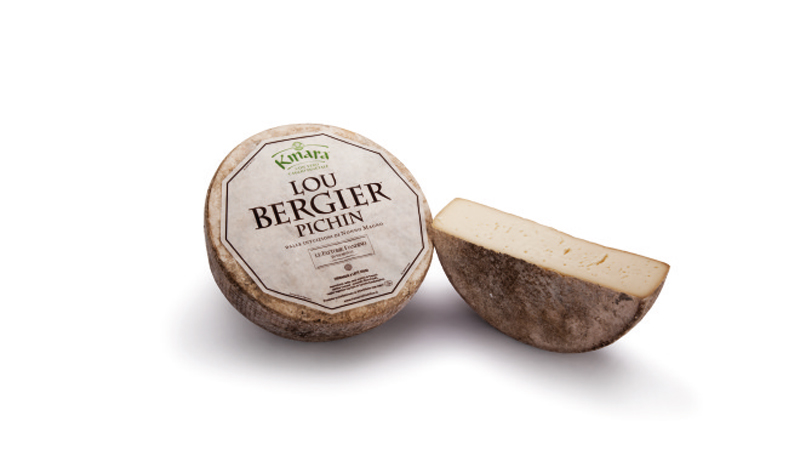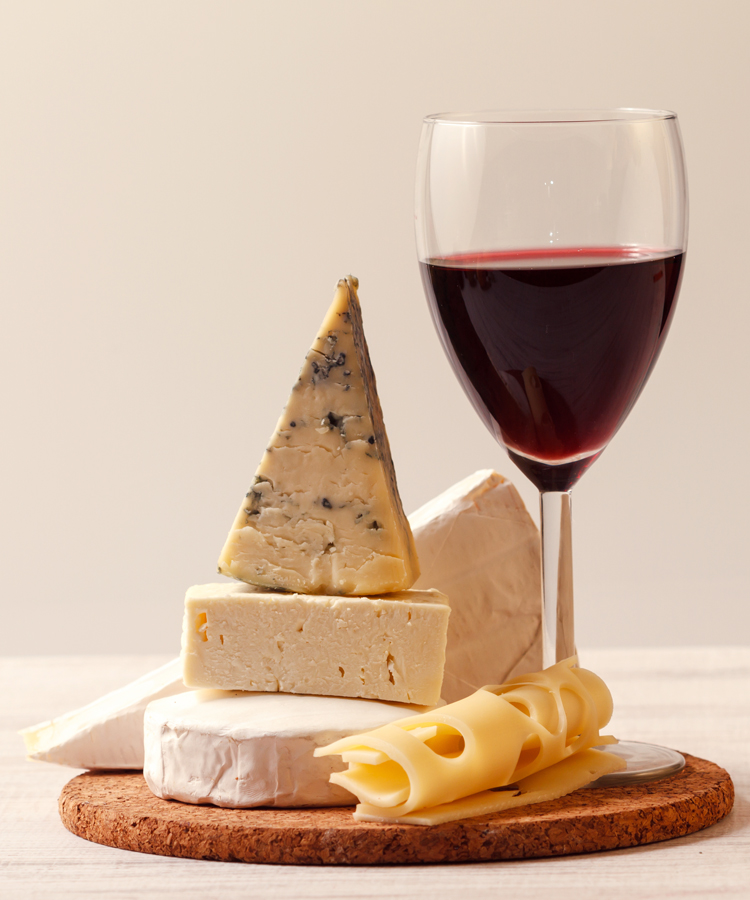
You might want to drink your glass (or two!) of Moscati d’Asti unadorned, with nothing but your stemware and a smile as accompaniment. In that case, drink on! Enjoyment is the name of the game, and there’s no wrong way to savor your favorite sip.
But sometimes, you want to make that Moscati d’Asti really sing. Why not pair it with La Tur, a cloud-like cheese made in Piedmont with a blend of cow, sheep, and goat milks?
Separately, both the wine and cheese are delicious. Together, their flavors marry to resemble the lightest cheesecake you’ve ever had — ripe, glistening fruit, decadent creaminess, and a bit of sweetness. Serve it with a few slices of Prosciutto di San Daniele to balance the sweetness, and you’ve officially elevated your evening.
For those of us hungry for harmony, there is nothing quite like matching your favorite wine with perfectly complementary cheese and charcuterie. No matter the wine and cheese, there are some general rules: creamier, younger cheeses tend to be better with white and sparkling wines, and harder, aged cheeses will pair better with red wine. Either way, a little bit of salty charcuterie ties it all together. Balance is the name of the game — as much as you love those creamy, milky cheeses, they likely will be overwhelmed by a big glass of Barolo. Open a bottle of Vermentino instead, however, and you’ve got yourself a gorgeous pairing. Italy offers an array of some of the most world-renowned wines, cheeses, and charcuterie, making it an ideal place to start when it comes to putting together a spread that you and your friends will love.
By artfully pairing Italian wines to regional cheeses and charcuterie, “you’re tasting a place,” Tia Keenan, cheese expert and author, says. These sorts of pairings bring culture, history, and geography to the table.
We asked some of the world’s leading wine and cheese experts for their favorite pairings and top tips. Here are four things to keep in mind when pairing Italian wine with cheese and charcuterie.
Layer Flavors
“It’s hard to go wrong with cheese and sparkling wine, but Prosecco and Bergamino di Bufala are an especially delicious pair,” Eli Joyce, Cheese Buyer and Education Lead, Cheese School of San Francisco, says.
Joyce believes the creamy, floral qualities of water buffalo’s milk are the perfect complement to the pear notes in Prosecco.
“The bubbles also help balance Bergamino’s decadent texture,” Joyce says. Ready to gild the lily? “I certainly wouldn’t be mad if one were to throw a little 24-month Prosciutto di Parma in there too — some salty minerality to top it all off!”
Don’t Fear the Atypical
Don’t be afraid to seek out unusual cheeses or pairings, says Carol Johnson, Certified Cheese Professional and Cheesemonger at Monger’s Palate in Brooklyn, N.Y.
“I love the unusual and delicate Lou Bergier Pichin paired with a Marzemino wine and Salame Felino,” Johnson says. Made from raw Bruna Alpine cow’s milk, and curdled with thistle rennet only, Lou Bergier is a semi-firm, cow’s milk toma.
“Marzemino’s bright sour-cherry acidity is cut by the dense creamy paste and brown butter earthiness of the Lou Bergier,” she says. Meanwhile, the Salame Felino (known colloquially in Tuscany as “finocchiona”) softens the thistle tang of the cheese and the tannic bite of the wine.

Learn the Names
“Like a big Italian family where all the cousins are named Giovanni, in Italy, Pecorino is a cheese and a wine, sharing not only a name but also flavor profiles,” Keenan says.
The two go beautifully together, with the mild, almost citrusy notes of younger, semi-firm Pecorino cheese playing off of the wine’s floral minerality.
“Of course, it’s best paired with some of the superlative pork-based charcuterie from central Italy,” Keenan adds.
All prosciuttos are not created equally, though. Prosciutto Toscano DOP is “typically cured with spices, setting it apart from more well-known iterations of prosciutto, like San Daniele or Parma,” Keenan says. Those spices complement your Pecorino wine and cheese pairing, bringing notes of fennel to the mix.
Embrace Red Wines
The diversity of Italian red wines provides ample pairing opportunities.
“Sangiovese is one of the true noble grape varieties of Italy and can be a shapeshifter, producing everything from soft, plush, and fruity wines to rich, leathery, and powerful ones,” Emily Schwed, Certified Cheese Professional, Convive Wines, New York City, says. She suggests pairing the stronger iterations, such as a 5- to 10-year-old Chianti Classico or Rosso di Montalcino, with Quadrello di Bufala, a washed-rind cheese made with buffalo milk.
“The salt and fattiness of the cheese really boost Sangiovese’s ripe plum and fig flavors,” Schwed says. “The whole thing is rounded out with a thin slice of Prosciutto di Parma, which ties the vegetal notes in the wine to the ultra-savory cheese.
Want to try something slightly farther afield? Frappato, an earthy, relatively light-bodied red variety planted primarily in Sicily, is a good foil for southern Italy’s aged sheep’s milk cheeses and spicy charcuterie.

“Frappato has quickly become one of my go-to reds,” Ashley Bryant, Education and Events Director, Dedalus Wine in Burlington, Vt., says. She thinks its fruity, “crunchy” quality can stand up to strong cheeses and salumi.
“Pair Bianco Sardo, a firm sheep’s milk cheese from Sardinia, with a lightly chilled glass of Frappato and a solid slice of Mortadella” Bryant suggests. “The sweet grassy notes in this basket-aged cheese highlight the floral and earthy quality of the wine.”
“Southern Italy is cranking out some outstanding (and affordable) bold reds,” Dan Belmont, Wine and Cheese Educator (London), WSET 3, London, says. “The robust Aglianico grape delivers on tannins, so it’s best balanced with rich pairings.”
Belmont suggests pairing it with Coppa salami. “The dark fruits of the wine will play well with the fatty pork goodness,” he says. “The formaggio of choice is Pecorino Calabrese. The aged sheep’s milk cheese brings herbs and savory notes to complete your Italian feast.”
White Wines Are Dreamy, Too
Though many of us know Italy for its red wines, the white wines are just as majestic and arguably more versatile.
“Arneis, a gorgeous Piemontese white, is my dream wine,” says Adam Goddu, a Certified Cheese Professional and Retail Director at Eden Boutique Taproom in Winooski, Vt. “It’s crisp, floral, and medium- to full-bodied, which pairs beautifully with so many of my favorite Italian cheeses. For instance, Toma Piemontese’s rich mushroom notes are exponentially enhanced with a glass of Arneis. Throw in a thin slice of Culatello to bring out the savory qualities in everything, and you are in pairing heaven!”
Because Italian wines have such unparalleled richness and vibrancy, they pair wonderfully with almost anything you can throw at them. Whereas many whites wouldn’t pair as well with rich beef dishes, something like Arneis or Vermentino can be truly lovely. So, while they’ll go with softer cheeses, harder cheeses can be just as wonderful.
This article is sponsored by The Italian Trade Commission.
